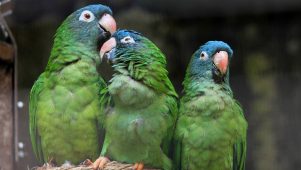The Language of Birds
Article By Julian Scott
 “We’ve been on earth all these years and we still don’t know for certain why birds sing. We need someone to unlock the code to this foreign language and give us a key; we need a new Rosetta Stone.” – Annie Dillard, Pilgrim at Tinker Creek
“We’ve been on earth all these years and we still don’t know for certain why birds sing. We need someone to unlock the code to this foreign language and give us a key; we need a new Rosetta Stone.” – Annie Dillard, Pilgrim at Tinker Creek
There have always been traditions about human beings with the ability to communicate with birds and understand their language, such as St. Francis of Assisi, who delivered a sermon to a flock of birds, or King Solomon who used birds as his informants. A story about an ancient Greek sage calledApollonius of Tyana tells how he interpreted the speech of some sparrows in a tree: one of them was telling the others how it had discovered some grain that had fallen from a cart, so the sparrows all went off to enjoy the feast. The sage told his audience what a good example these sparrows were for human beings, who, when they become wealthy, try to keep it all for themselves.
There are also many stories of birds communicating with human beings in order to help them. One writer cites the recent case of an old lady who fell down a cliff onto a beach and was saved by a seagull who alerted her sister. It did this by tapping vigorously on the window with its beak and flapping its wings frantically until she came outside. It then guided her to the edge of the cliff where the old lady had fallen down. This was a seagull which the two sisters used to feed regularly, so it knew them well.
In many ancient cultures, such as the Egyptian, Greek, Etruscan and Roman, the flight of birds, and later the entrails of sacrificed birds, were studied by specialist priests to divine the future. It is also said that Hermes invented the alphabet by observing the flight of cranes. These examples reinforce this concept of birds as messengers from another world, through whom one can come to understand the mind or soul of nature.
The intelligence of birds
These and other stories lead to questions about the intelligence of birds, and there are two types of bird which are particularly well-known in this regard: parrots and crows. We normally think of parrots as mere imitators, but a ten-year experiment by a researcher from the University of Arizona led to the conclusion that parrots are capable of learning to understand human language and respond to it with meaningful sentences of their own.
Crows have been shown to have the ability to make tools. One experiment involved supplying two New Caledonian Crows with two pieces of wire, one straight and one hooked, with which to extract some small buckets of meat from the end of a tube. The first crow chose the hooked wire and successfully retrieved the meat, flying away with the wire as well. The second crow, being left with the straight piece of wire, fashioned it into a hooked wire tool and so also managed to obtain its food.
Even in the ancient world, the intelligence of corvids was well-known and one of Aesop’s fables concerns a crow which worked out how to drink water from a narrow-rimmed jug by dropping stones into it so that the water would rise to the top.
Communication between birds
Another way of looking at the question of the language of birds is to analyse their communication with each other. What are birds saying to each other when they tweet or sing?
The meaning of some bird calls has been identified by behavioural studies. For example, birds will make alarm calls when a predator is approaching, they will sing to attract a mate or screech to assert their right to territory. But much remains unknown and the complexity of bird language is becoming steadily more apparent.
For example, it has been found that American Chickadees have not one, but several distinct alarm calls that correspond to different types of predator, according to the level of threat. Different types of meaning are also conveyed by whether the glissando
of a bird’s call is ascending or descending, even if the musical interval is the same. With one the bird may be saying “come here”, with the other “go away”.
If there is more complexity in the language of birds than we had previously suspected, can we talk about ‘bird conversation’? Does their language go beyond the purely instinctual? This is something that is very difficult, perhaps impossible, to know. We could also reduce all human activity to mating and territoriality if we merely observed human behaviour in a superficial way. It may be, therefore, that birds also greet each other, sing together for pleasure, express gratitude at the rising of the sun, discuss the weather and indulge in social gossip.
The celebrated Austrian naturalist Konrad Lorenz observed many instances of human-like social behaviour among birds in his classic work King Solomon’s Ring
. One of these concerned the boss male of a group of Jackdaws who ‘fell in love’ with a female who had previously occupied a very low position in the group’s hierarchy and had often been bullied. When she became the leader’s mate, however, the other birds’ attitudes towards her changed, she began to be treated as the ‘president’s wife’ and she herself began to throw her weight around accordingly. If birds have these complex social interactions, it is not beyond belief to consider the possibility that they may in some way ‘talk’ or communicate about these matters.
A study referred to in The Human Nature of Birds
by Theodore Xenophon Barber revealed that“When microphones were placed secretly in places where crows rested and ate, it was discovered that the birds made many more, often whispered, sounds than had been suspected. The researcher in this case made a note that ‘they hold conversations… as if they were reviewing the day’s events.”
Birds also use particular sounds to express emotion. Swans make a honking sound when angry. Other birds emit calls like battle-cries when they want to scare off a potential predator. But the naturalist Alexander Skutch (1904-2004), the world’s foremost expert on Neotropical birds, goes further than this. In one of his many books – The Minds of Birds
– he attributes human-type emotions to bird vocalizations. One example he gives is the universal phenomenon of the Dawn Chorus. While the television naturalist David Attenborough suggests that birds sing most strongly at dawn because, amongst other reasons, sound travels particularly well in the early morning, Skutch maintains that at the sight of the rising sun, birds experience heightened emotion.
Other birds use ‘drumming’ techniques to convey their messages. The Greater Spotted Woodpecker, for example, selects a hollow branch or dead trunk for its resonance and hammers out twenty blows a second. The message depends on the frequency and speed of the blows. The human ear is incapable of deciphering them, but analyses of recordings can do so.
The musical language of birds
One of the most common but least understood forms of bird language is birdsong. However, although its purpose is still largely a matter of speculation, it has been much researched.
The singing capacity of birds is largely due to the fact that they do not, like humans, use the larynx to produce their songs, but a structure called the syrinx which is possessed by no other creatures. It divides into two tubes which can be operated independently and are thus able to make more than one sound at the same time. When the bird contracts its lungs, a jet of air is blown through each pair, creating a musical sound.The sound can also be varied by the windpipe, which may be longer or shorter according to the bird. As a result of this complex structure, some songbirds are capable of producing as many as 80 notes per second, although the human ear may perceive this as a single continuous note. But sound spectograph recordings of birdsong tell the true story.
A bird song may contain up to 2,000 repeated elements or ‘strophes’ and is the most elaborate series of messages in the language of birds. It is impossible, by the study of behaviour alone, to understand the full range of reasons why birds sing. All authors seem to agree that we do not have the complete picture and any dogmatic assertions should be avoided. As to the meanings contained in birdsong, we can gain some insights by an analysis of its musical structures.
If we are to look for comparisons with human music, the most similar form to birdsong is probably that of the Indian Raga which has a more subtle and discursive structure than Western music. Birdsong clearly has a musical structure, but it is very elusive for the human ear.
In Secrets of the Soil,
the authors Christopher Bird and Peter Tomkins also noted a similarity between birdsong and the Indian Raga, and claim that both these musical forms – but most particularly birdsong in the form of the Dawn Chorus – seem to have a remarkably stimulating effect on plant growth. Could birdsong have an unsuspected function in nature, based on the power of sound, vibration and resonance?
In conclusion…
As with many areas of nature and life, what we know is little in comparison with what we do not know. There are perhaps two ways to understand the language of birds: one is the rational-scientific, which arrives at its conclusions by behavioural studies, spectographic measurements and musical analysis. It can teach us much, but is always limited. The other way is intuitive, by learning to read in the Book of Nature. Until we have developed our higher intuition we have to be satisfied with the first method, but even this can open doors that were closed before. As all roads lead to Rome, so all research leads to the understanding that every world is a microcosm of the whole. In nature, everything is communicating, even the tiniest bacteria. Each world has its language, a gateway to understanding the beings that inhabit it.
Image Credits: By Mickey | Flickr | CC BY 2.0
The entity posting this article assumes the responsibility that images used in this article have the requisite permissionsImage References
By Mickey | Flickr | CC BY 2.0
Read the original article on http://ankh.newacropoliscanada.org/news/36-the-language-of-birds-by-julian-scott
Article References
Attenborough, David, The Life of Birds, BBC Books, London 1998 Barber, Theodore Xenophon, The Human Nature of Birds, Penguin Books, 1994 Bird, Christopher & Tomkins, Peter, Secrets of the Soil, Arkana, London, 1992 Lorenz, Konrad, King Solomon’s Ring, Methuen, London, 1964 Nozedar, Adele, The Secret Language of Birds,HarperElement, London 200 Perrins, Christopher, Bird Life– An introduction to the world of Birds, Magna Books, Leicester, 1992 Powers, Alan, BirdTalk – Conversations with Birds, Frog Ltd., Berkeley California, 2003 Skutch, Alexander, The Minds of Birds,Texas AM University Press, Texas 1996 Tudge, Colin, The Secret Life of Birds, Penguin Books, London, 2009 Van Dalen, Cornelis, The Dawn Chorus, New Physis Newsletter Issue 10 Autumn 2006, Woldingham, Surrey 2006 news.bbc.co.uk/1/hi/sci/tech/2178920.stm (BBC article on the work of Alex Kacelnik with Crows www.eurekalert.org/features/kids/2005-06/aaft-bcw061705.php (Press release on Chickadee research) (Video on bird communication)



